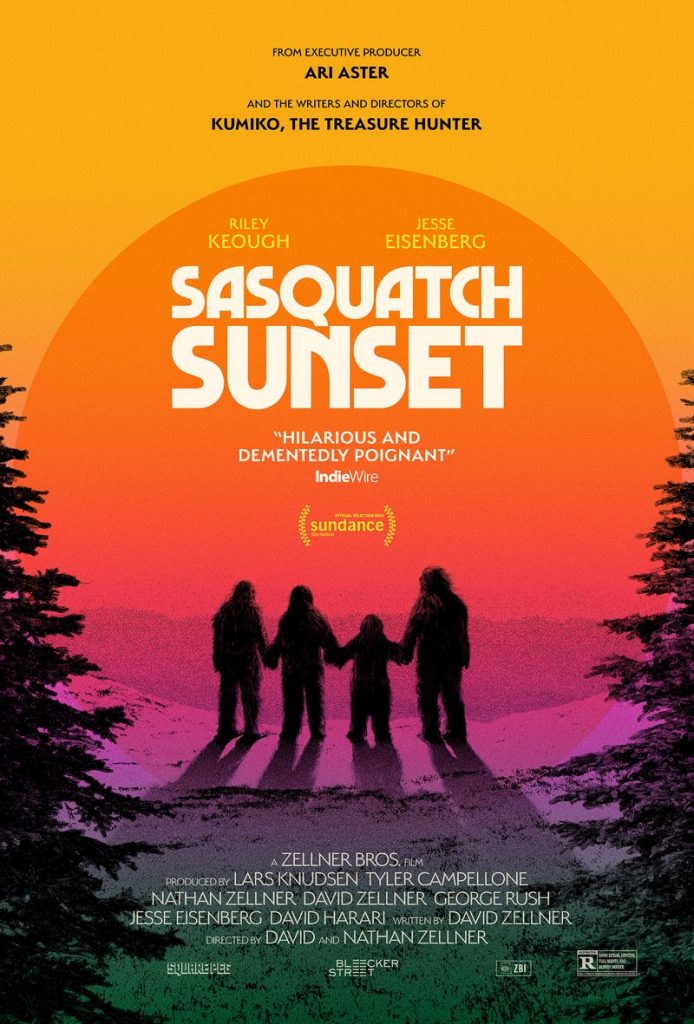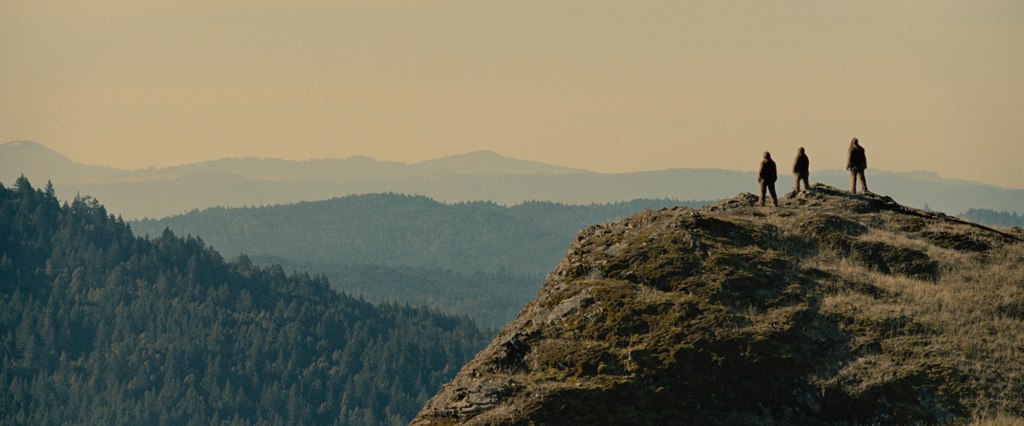
Something strange is stirring in the wilderness. But unlike the devoted cryptid enthusiasts of reality shows like Finding Bigfoot, you won’t have to camp out in remote reaches of the Rockies to catch a glimpse.
Instead, the new film Sasquatch Sunset puts its namesake mythical creature in the center of the frame. Starring Jesse Eisenberg and Riley Keough as part of a family of Sasquatches, the film by brothers Nathan and David Zellner follows the pack over the course of 12 months as they find themselves on a collision course with the changing world around them. Covered head to toe in make-up, prosthetics and fur, the cast is unrecognizable. There is no dialogue — only grunting.
Produced by modern “elevated horror” provocateur Ari Aster, Sasquatch Sunset is quickly generating buzz as one of the year’s most unexpected films. Fresh off directing stints on the cringe-inducing black comedy The Curse starring Nathan Fielder and Emma Stone,the Zellner brothers return to their directors’ chairs with David writing the screenplay and Nathan in a starring role. But while the family team may be off-the-map creatively, their origins trace close to home in Greeley, where they were born and raised.
“Every weekend, our family would go to the Rockies or Estes Park,” David Zellner tells Boulder Weekly over Zoom. “We were always out in the wilderness. That really helped to establish our love of nature and our interest in Bigfoot. It really endeared us to the subject matter.”
Growing up in Greeley, the brothers would make short films on their dad’s Super Eight camera in the backyard. With nature as their backdrop, the pair often used stop-animation to pay homage to the media they loved.
“Like a lot of kids, we’d spoof what we’d been watching. So there was a lot of action and horror movie ripoffs,” David recalls. “After a while, we started to find our own voice. But everything we made had lots of stuff in the wilderness. It’s never intentional, but we always find ourselves out there.”
Looking back on the brothers’ first attempts at filmmaking, David sees a connection between those early efforts and Sasquatch Sunset: “It still feels like we’re running around the woods with a camera and getting our friends to help us with these crazy ideas.”

‘The mysteries of nature’
Sasquatch Sunset is not the Zellners’ first film to revolve around the elusive cryptid sometimes known as Bigfoot. Their five-minute short film Sasquatch Birth Journal 2 premiered at the Sundance Film Festival in 2011. Billed as “an unprecedented peek at the mysteries of nature,” the film depicts a human-like wood ape — played by Nathan — in the throes of labor.
“It was pretty successful in the film festival circuit,” David says. “That was birthed from all of the online Bigfoot sightings, where they’re always sitting down, lurking or never doing anything interesting.”
The pair began to joke about what else a family of Sasquatches might get up to. With lots of ideas percolating, they started to take it more seriously and build a world.
“We really wanted to take a look at the interior lives of the creatures,” David says. “Right from the start, we knew we wanted it to be from their perspective, and not just be another Bigfoot movie through the eyes of humans.”
In order to stay true to their vision, the pair knew Sasquatch Sunset would require zero dialogue. This approach made things more challenging, but it opened the door to new modes of storytelling.
“We knew we’d need a rich sound design and we’d have to get the exposition across through visual means exclusively,” David says. “The subtlest of facial expressions conveys their needs, desires and heartaches.”

Free and feral
As the pair were working out how to bring Sasquatch Sunset to life, they had to “rewire” their brains to adapt to the challenge. David approached it like directing a silent movie, focusing on the facial expressions and physicality of his actors. Rather than feeling restrained, he says it was liberating.
Both Eisenberg and Keough jumped at the opportunity. “They immediately got the tone of the script, the story and the characters, and were instantly up for the adventure,” Nathan says. “That was just so rewarding to get their feedback like that.”
The foursome then began the process of rehearsing and preparing for exactly how to portray a Sasquatch. “We wanted to use Bigfoot as a foundation,” Nathan says. “But we really saw it as us creating our own species. We want to make sure we all looked like the same creature and moved and communicated the same way. We needed the audience to tell that we were a family or a pack or whatever, and had a connection.”
While David’s script distinctly rendered each furry character, the actors added their own nuances to make sure they all stood out from each other. For several weeks, Eisenberg, Keough, the Zellners and Christophe Zajac-Denek worked with movement coach Lorin Eric Salm to bring consistency to their movements. The catch? They could only do it over Zoom.
“That made it a little awkward,” Nathan says. But after a few weeks, the actors let loose in a park where they could be free and feral. When they finally put on creature designer Steve Newbern’s suits and arrived in Northern California to shoot, the quartet instantly felt transformed.
“Everybody had this epiphany moment,” Nathan says. “You could really feel the power in the bulky suits. The weight of them really influenced how you moved. At that moment, we all looked at each other and knew that it was going to be special — and a lot of fun.”
ON SCREEN: Sasquatch Sunset opens in theaters April 19.
